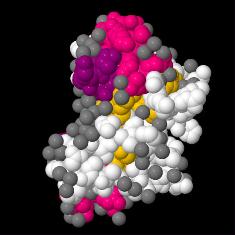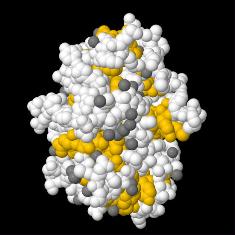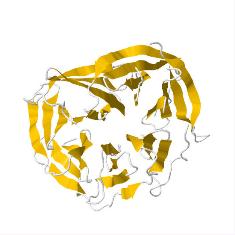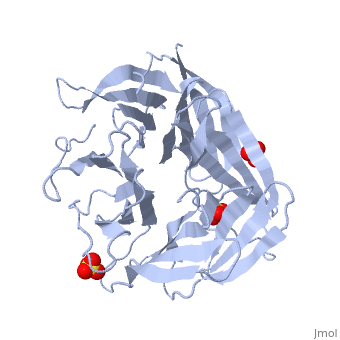Prp19
From Proteopedia
| |||||||
| Prp19 WD40 domain complex with sulfate, 3lrv | |||||||
|---|---|---|---|---|---|---|---|
| Ligands: | |||||||
| Gene: | PRP19, PSO4, YLL036C (Saccharomyces cerevisiae) | ||||||
| |||||||
| Resources: | FirstGlance, OCA, RCSB, PDBsum | ||||||
| Coordinates: | save as pdb, mmCIF, xml | ||||||
Contents |
Introduction
Prp19 (precusor RNA processing 19) is a splicing factor which is essential for proper pre-mRNA processing.[1]Its presence is required prior to the first splicing step, in which the 5' splice site is cleaved and a lariat intron/3' exon intermediate is formed. Through various isolation methods, over 40 PRP genes have been identified[2] - many of which have very similar homology and motifs such as Zinc fingers, RNA binding motifs, ATP dependent helicase and a motif for the beta subunit of G protein.[3] However, PRP19 had no homological similarities to any known sequences. The function of PRP proteins can be broken down into three main categories, those involved in the first chemical step, such as PRP19, those involved in the accumulation of splicing intermediates, and those involved in the formation of the lariat-intron product. [3]
Structure
In Humans, the gene which is homologous to that of PRP19 in S. cerevisiae is located on chromosome 11 (11q12.2).[4] The protein is 503 amino acid residues in length and forms a tetramer with a centrally coiled domain[5]. The protein was found to have a molecular weight of 56 kDa [6]Two majors functional domains have been identified, the WD40 domain and the U Box domain[7]
U-Box Domain
 This is a CPK coloured representation of the U Box Domain of PRP19. The secondary structure can be seen .
This is a CPK coloured representation of the U Box Domain of PRP19. The secondary structure can be seen .
U-Box proteins are a class of ubiquitin ligases whose structures are generally stabilized by hydrogen bonds and or salt bridges.[8] In mammals, these proteins have been found to associate and interact with molecular chaperons such as HSP90 and HSP70, providing evidence that they may be involved in the degradation of mis-folded proteins.[9] PRP19's U-Box domain is located at the beginning of its amino acid sequence and is comprised of 61 residues. The U-Box domain's structure was first solved by NMR in 2003[10] and by X-Ray crystallography in 2006[5]. The protein was purified from yeast (S. cerevisiae) and the resulting crystal structure was solved via X-Ray diffraction at a resolution of 1.5 Angstroms and revealed that the U-Box fragment consisted of six chains.
WD40 Domain
 This is a CPK coloured representation of the WD40 Domain of PRP19.
This is a CPK coloured representation of the WD40 Domain of PRP19.
 Secondary Structure of the WD40 Domain of PRP19. The Beta Propeller fold can be seen.
Secondary Structure of the WD40 Domain of PRP19. The Beta Propeller fold can be seen.
WD40 domains can be found throughout a large variety of organisms and are highly abundant in eukaryotic proteins[11]. WD40 domains can have several functions including cell cycle control, involvement in signal transduction, assembly of the cytoskeleton, gene transcriptional activation and pre mRNA processing. Conserved repeats ~40 residues long, consisting of tryptophan and aspartic acid residues, form a Beta Propeller fold which can be seen in the image above, as well as in the default scene image. The default scene also shows 4 SO4 molecules binding which help to activate the complex. Blade repeats can often be used as platforms for binding of other proteins or ligands.[12][13]. The propeller fold in PRP19's WD40 domain is comprised of seven blades and is asymmetrical due to a slight distortion in blades one and seven. The region around blade five is highly conserved and is necessary for interaction between PRP19 and Cwc2, another splicing factor found in the NTC. The WD40 domain of PRP19 is found between residues 165 and 503. Its structure was solved in 2010 by X-Ray diffraction at a resolution of 2.6 Angstroms.[7]
Role in Splicing
Research has shown that different PRP proteins are involved in splicing in very different ways. For instance, some PRP proteins are directly associated with snRNPs (snurps) such as PRP8 and PRP18, which are associated with the U5 snRNP. Others interact with snRNA at different times, such as PRP17 and PRP18 with U5, which are thought to play a functional role. Certain PRP proteins are involved in specific steps, such as PRP2's involvement in the first cleavage / ligation reaction. Furthermore, some PRPs play a role in snRNP binding. That is, PRP9, PRP11 and PRP21 are thought to help promote U2 binding early on in the spliceosomal assembly process. [2] Another important role of PRP proteins is helping to anneal the snRNPs themselves. An example of this is PRP24 aiding in the association of U4 and U6, which form the di-snRNP[14].
Studies have found that PRP19 associates with the spliceosome around the time that the U4 snRNP disassociates from the complex. This is thought to be evidence towards PRP19's involvement in the conformational rearrangement that occurs at this stage of the splicing process.[2] Other evidence suggests that PRP19 acts to stabilize the association of U5 and U6 with the active spliceosome. Researchers have also suggested that PRP19 is part of a heteromeric complex which is comprised of at least eight different proteins, coined the nineteen complex, or NTC.[15] There is also evidence that PRP19 may be part of an even larger complex consisting of the U2, U5 and U6 snRNA as well as many other proteins.[16]
The Nineteen Complex
The NTC consists of at least 8 protein components and is associated with the spliceosome as U4 dissociates or immediately thereafter. Research has shown that the PRP19 associated complex is required for a reaction in which the structure of the U6 snRNP is re-arranged, involving destabilization of Lsm proteins. This destabilization is thought to help facilitate interaction between the intron closest to the 5’ splice site and the Lsm binding site of U6.[17] The NTC may also function to increase specificity between the U5 snRNP and the 5' splice site. Additionally, it may play a role in the specificity of the base pairing between U5 and U6. Currently it is uncertain whether base pairing between U2 and U6 requires participation of the NTC complex.[18]
3D structures of pre-mRNA-splicing factors
References
- ↑ Tsai WY, Chow YT, Chen HR, Huang KT, Hong RI, Jan SP, Kuo NY, Tsao TY, Chen CH, Cheng SC. Cef1p is a component of the Prp19p-associated complex and essential for pre-mRNA splicing. J Biol Chem. 1999 Apr 2;274(14):9455-62. PMID:10092627
- ↑ 2.0 2.1 2.2 Tarn WY, Hsu CH, Huang KT, Chen HR, Kao HY, Lee KR, Cheng SC. Functional association of essential splicing factor(s) with PRP19 in a protein complex. EMBO J. 1994 May 15;13(10):2421-31. PMID:8194532
- ↑ 3.0 3.1 Cheng SC, Tarn WY, Tsao TY, Abelson J. PRP19: a novel spliceosomal component. Mol Cell Biol. 1993 Mar;13(3):1876-82. PMID:8441419
- ↑ "Entrez Gene: PRPF19 PRP19/PSO4 pre-mRNA processing factor 19 homolog (S. cerevisiae)". http://www.ncbi.nlm.nih.gov/sites/entrez?Db=gene&Cmd=ShowDetailView&TermToSearch=27339.
- ↑ 5.0 5.1 Vander Kooi CW, Ohi MD, Rosenberg JA, Oldham ML, Newcomer ME, Gould KL, Chazin WJ. The Prp19 U-box crystal structure suggests a common dimeric architecture for a class of oligomeric E3 ubiquitin ligases. Biochemistry. 2006 Jan 10;45(1):121-30. PMID:16388587 doi:10.1021/bi051787e
- ↑ Lu X, Legerski RJ. The Prp19/Pso4 core complex undergoes ubiquitylation and structural alterations in response to DNA damage. Biochem Biophys Res Commun. 2007 Mar 23;354(4):968-74. Epub 2007 Jan 26. PMID:17276391 doi:10.1016/j.bbrc.2007.01.097
- ↑ 7.0 7.1 Vander Kooi CW, Ren L, Xu P, Ohi MD, Gould KL, Chazin WJ. The Prp19 WD40 domain contains a conserved protein interaction region essential for its function. Structure. 2010 May 12;18(5):584-93. PMID:20462492 doi:10.1016/j.str.2010.02.015
- ↑ pmid:11274149.
- ↑ http://smart.embl-heidelberg.de/smart/do_annotation.pl?ACC=SM00504
- ↑ Ohi MD, Vander Kooi CW, Rosenberg JA, Chazin WJ, Gould KL. Structural insights into the U-box, a domain associated with multi-ubiquitination. Nat Struct Biol. 2003 Apr;10(4):250-5. PMID:12627222 doi:10.1038/nsb906
- ↑ pmid:11814058.
- ↑ http://pawsonlab.mshri.on.ca/index.php?option=com_content&task=view&Itemid=64&id=190
- ↑ Smith TF, Gaitatzes C, Saxena K, Neer EJ. The WD repeat: a common architecture for diverse functions. Trends Biochem Sci. 1999 May;24(5):181-5. PMID:10322433
- ↑ Raghunathan PL, Guthrie C. A spliceosomal recycling factor that reanneals U4 and U6 small nuclear ribonucleoprotein particles. Science. 1998 Feb 6;279(5352):857-60. PMID:9452384
- ↑ Makarova OV, Makarov EM, Urlaub H, Will CL, Gentzel M, Wilm M, Luhrmann R. A subset of human 35S U5 proteins, including Prp19, function prior to catalytic step 1 of splicing. EMBO J. 2004 Jun 16;23(12):2381-91. Epub 2004 Jun 3. PMID:15175653 doi:10.1038/sj.emboj.7600241
- ↑ Ohi MD, Gould KL. Characterization of interactions among the Cef1p-Prp19p-associated splicing complex. RNA. 2002 Jun;8(6):798-815. PMID:12088152
- ↑ Chen CH, Kao DI, Chan SP, Kao TC, Lin JY, Cheng SC. Functional links between the Prp19-associated complex, U4/U6 biogenesis, and spliceosome recycling. RNA. 2006 May;12(5):765-74. Epub 2006 Mar 15. PMID:16540691 doi:10.1261/rna.2292106
- ↑ Chan SP, Cheng SC. The Prp19-associated complex is required for specifying interactions of U5 and U6 with pre-mRNA during spliceosome activation. J Biol Chem. 2005 Sep 2;280(35):31190-9. Epub 2005 Jun 30. PMID:15994330 doi:10.1074/jbc.M505060200

